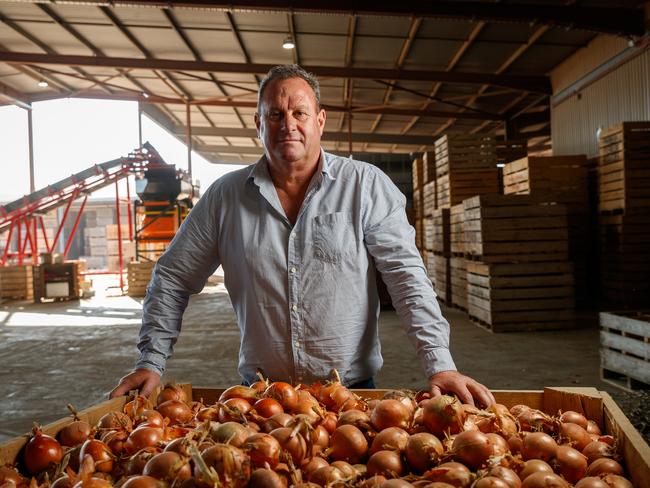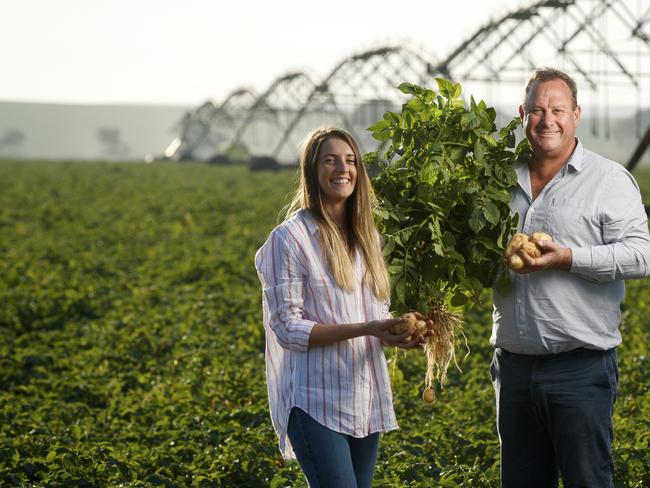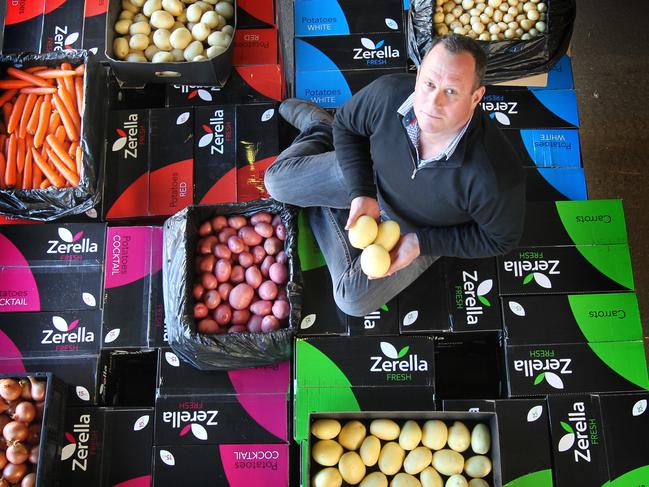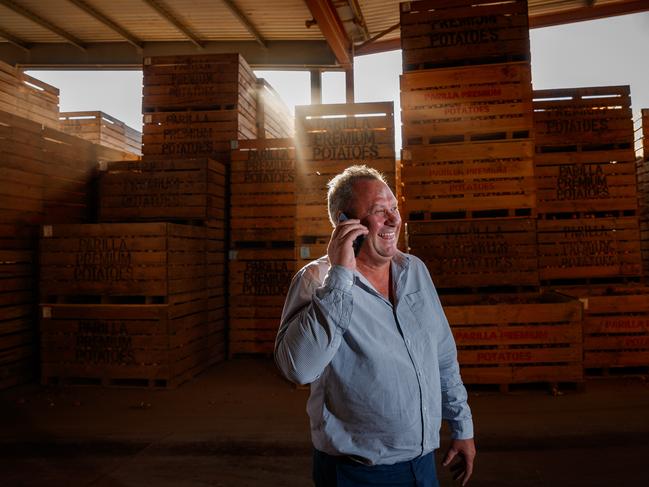The Pye family know their onions, their carrots and most of all, their potatoes
New Zealander Mark Pye was 22 when he moved to the Mallee. Three decades later, his family runs one of the biggest vegetable farms in Australia.

SA Weekend
Don't miss out on the headlines from SA Weekend. Followed categories will be added to My News.
- SA WEEKEND:Former PM Malcolm Turnbull says he would love to still be in charge
- South Australians turning to local wine, beer during shutdown
- How to get the most out of your Advertiser digital subscription
Mark Pye nearly cashed in his chips early. Internal fleck will do that to you. The Kiwi had come to South Australia in 1990 to start growing potatoes out in the Mallee region, near the border with Victoria.
Pye had done his research. He knew what he was after. He came from a successful horticulture family in New Zealand and his father was keen to expand the business. But the first couple of years were tough. Pye had a contract from the food giant McCain to grow potatoes that could be turned into french fries and be sold by fast food companies such as McDonald’s.
It turns out there are thousands of varieties of potato and, back then, the one used most often for french fries was called a russet burbank. An American variety.
“McDonald’s want all those chips that poke out the top – the big, long ones,” Pye says. “They are long, skinny ones. They are special varieties. And they want them high in solids, too – they don’t want them full of water – so the chips are crunchy and not soggy.”
But in the early days, it wasn’t quite working out for Pye. He had picked the area around Parilla, between Pinnaroo and Lameroo, because the land was relatively cheap, there was a lot of it, the soil was good and there was access to water.
The one thing that he hadn’t counted on was just how hot it could get. Out on the endless plains of Parilla, that flat, shimmering Australian heat wasn’t ideal for growing that particular variety of potato. It would turn out other spuds could cope, but the dear old russet burbank was made from more delicate stuff.
“Those potatoes don’t like it out in the field when it’s 48 degrees,” Pye says, before adding in a little subconscious potato humour. “They get fried.”
Which brings us back to internal fleck: a defect which causes brown spots to appear in potatoes.
“This fleck was caused by stress,” Pye says. “It had been too hot for too long and they said, ‘It’s not working and we don’t want to take your potatoes’.”
Pye had 3000 tonne of those potatoes. In the early days of the business this was about a third of his total crop. If it fell over, the business would be in a lot of trouble. But Pye is the persistent sort. He worked out a deal. McCain took the potatoes but also told him he would not be getting another contract if they continued to grow the potatoes in Parilla.
It was a tough introduction to life in Australia. Pye was only 22 when he came here with his new wife Fiona in 1990. He was the oldest of five brothers and sisters, so the challenge of expanding the family business in a foreign land fell to him.
And there were times Pye thought it might all be beyond him.
On a visit home to New Zealand in the early days he expressed some doubts to his father about whether they would make any money out of this Australian venture.
“He looked at me and said, ‘I think you should come home – just forget about it’.”
Pye says now he thinks his father was just trying to challenge him. To see if he was really tough enough to withstand the ups and downs that naturally come with life on the land.
“I said, ‘I think I can make it work, just give me another year or two’,” he remembers. “You give things a crack, don’t you? Don’t want to get to 50 and decide I haven’t really pushed myself. The worst thing that could happen is that we would have to go home. Maybe pretty stupid, but it’s worked out OK.”

Pye did make it work. Three decades later, sitting in his comfortable home just outside Parilla, overlooking the swimming pool and with the air sock fluttering over the air strip he uses to fly to different parts of his empire, he has become one of Australia’s largest growers of potatoes, onions and carrots.
The business generates more than $100 million a year, grows 17 per cent of the nation’s washed potatoes, 24 per cent of its carrots and 27 per cent of its onions through its Zerella Fresh operation. In raw number terms, this means Pye grows 120,000 tonnes of potatoes, 40,000 tonnes of carrots and 50,000 tonnes of onions a year.
Around Parilla, the 52-year-old Pye owns about 32,000 hectares. Growing potatoes, onions and carrots takes a lot of water. To grow potatoes you need 7-8 megalitres per crop a hectare. Carrots and onions are similar. Comparatively, cereal crops for grain or seed usually require 2.4 megalitres per hectare, while the average pasture field for grazing is about 3.5 megalitres per hectare.
But the farm sits above what is called the Murray Group Limestone aquifer. It contains a lot of water. A State Government report in 2017 said if all entitlements across the Mallee – not just by the Pyes – were used in full, in 300 years the aquifer would be depleted by 15 per cent.
Pye started with a handful of workers, including some family friends from New Zealand, and now has about 365 employees. It’s a figure which makes him shake his head a little. “Scary,” he says. “Doesn’t pay to think about it too much.”
Pye still has that straightforward air of the farmer about him. When we walk through the onion-processing factory – something which brings tears to the eyes, from the sting of onions – he knows the names of the workers and dispenses little bits of advice here and there.
On the wall hang big TV screens detailing when the next load of onions is scheduled to depart to supermarkets all around Australia. Onions tumble through conveyor belts and are scanned and X-rayed for quality before being packed into boxes.
All of which means Pye did manage to solve the problem with the russets and the internal fleck.
The answer was to buy land at Mt Benson, near Robe, in the cooler climes of the state’s southeast. It worked in a growing sense but the 600km round trip to visit his new land soon became tiresome and Pye decided he needed to find a quicker mode of transport. He took flying lessons.
It took him five months to pass his tests and he bought a little Cessna 102 that had been previously bought by the Queensland Government for its premier, Joh Bjelke-Petersen.
Back in the early 1990s, Pye says, the potato market was evolving.
“The market in the east coast was changing from people chipping off dirt and peeling them all to potatoes that didn’t need peeling,” he says. “There was an opportunity there to fill with washed (potatoes), particularly in NSW and Victoria.”
They were in the right place to supply those potatoes. Somewhere around 80 per cent of the nation’s washed potatoes are now grown between Parilla and the Riverland. Pye says the location also works in a transport sense. Parilla is only a couple of hours from Adelaide, and Sydney and Melbourne are only a day away.
Soon after the Pyes arrived in Australia they hooked up with the Zerella family, growers in Virginia. But over time the Pyes bought out their partners and the business grew swiftly after those first few bumpy years.
Pye has also been an innovator. One of the company’s biggest successes has been the introduction of the potato it markets as Spud Lite. Despite only hitting the shops in 2015, it now makes up 20 per cent of the company’s sales.
One thing to understand about the world of potatoes: There are lots and lots of different varieties of the good old-fashioned spud, and more are being created all the time. For example, in your ordinary 2kg bag of spuds you pick up from the supermarket there could be as many as four different varieties.

It turns out the global home of the potato is the Netherlands. Pye is a regular visitor to keep up with the latest research and developments. He tastes new versions of potatoes – ones that have been created through cross pollination to achieve a particular outcome. The potatoes also have to pass through the Parilla “family panel”, which convenes to pass judgment on the latest type of spud.
Pye is keen to point out none of this is done through genetic modification.
“(It’s) just natural flowers, birds and bees, just crossing varieties,” he says. “You go to their breeding houses and they have got 500 varieties of new potatoes coming through. You can say, ‘I want a yellow or a smooth skin’, ‘it needs to like the heat’.” The breeders take you out to a batch.
“You spend the whole day digging potatoes by hand, take them in, cook them up and taste them.” Which is how he found a variety called maranca.
“It was eating really well, yielding well, good appearance and then we started doing some carb testing on them and found out it was low carb. Twenty-five per cent lower than average,” he says.
It also takes about 100 days to grow a maranca, which is 20-30 days shorter than other varieties, which also means a saving on commodities such as water and fertiliser.
“It’s a bit of a freak,” Pye says.
Launching the business’s Spud Lite brand in 2015 was the first big job for Mark’s daughter Renee, who had grown up on the Parilla farm.
She had sat on the backs of tractors, helped with planting and walked up and down the rows of potatoes, checking for disease. But she also went to university to study a business management degree, focusing on marketing.
Woolworths was the first to take the Zerella Fresh maranca marketed as Spud Lite. A year later Coles wanted them as well.
“It’s grown a lot after that, then we decided we would put it in the independent markets as well,” Renee Pye says.
The 25-year-old says people are more interested these days in where their food comes from, and are prepared to pay a little more for products they believe to be of higher quality or that deliver a health benefit.
“They are starting to demand to know where their potatoes come from, where they are grown,” she says. “I think consumers are now caring about what they are putting into their mouths. They want to be healthy, they want to live longer.”
Having a brand such as Spud Lite, says her father, also brings greater market power than just having generic potatoes to sell to supermarket giants such as Woolies and Coles. “It’s our brand and our packaging so we can say to the supermarkets, ‘this is the price’,” Mark Pye says. “You wouldn’t say ‘take it or leave it’ but it’s easier to negotiate.”

He believes innovation will be the key to further growth. But he also says potato growers have to return to delivering potatoes that taste good.
“We all started looking at yield and pack quality and forgot about the taste of them,” Pye says. “Some of the varieties we started using 10 years ago had no taste. I think it put people off potatoes.
“They would go and buy a bag, boil them up and there was just a big mess at the bottom of the pot and they thought ‘I’m not having that experience again’.”
He believes varieties such as the maranca can change that.
Mark and Renee Pye have more ideas they are pursuing, including pre-packaged flavoured spuds. The idea being to pop a bag of potatoes in the microwave, give it six minutes, break the seal and put in a flavour. Maybe herb and garlic. Or buttery garlic or cheese.
“It could be a game changer for the potato industry,” Renee says. “Everyone thinks they take so long to cook and hopefully this helps.”
They have ideas for export as well. Export is only about 10 per cent of the company’s business, but they believe Asia is promising and are developing small 350g packs to sell.
“The Asian market is very interested in small, convenient-sized packs that you can put in the microwave or cook up really quickly,” Renee Pye says.
The lack of exports has helped the Pyes survive the coronavirus crisis. Indeed, sales boomed in the early days of the pandemic as people bought food to cook at home. Sales of Spud Lite were up 60 per cent and other potatoes up about 50 per cent, while carrots and onions sold around 40 per cent more. But the spike involved packing and shipping extra volumes that were ready to go. It’s hard to increase production quickly of crops that take three months to grow.
The downside of COVID-19 has been the obvious drop in sales to restaurants and cafes, which makes up 20 per cent of the business.
Still, the Pyes have increased the workforce, while at the same time trying to enforce social distancing. Visitors are now banned from the site, while workers are temperature checked every day and are eating lunch in their cars.
The Pyes’ operation also takes in cattle, sheep, wheat and barley. But Mark Pye’s next great passion will be growing grapes and making wine in the McLaren Vale. He sees himself and wife Fiona retiring there one day. He has planted vines, mainly shiraz, on 30 hectares near Aldinga, and has chosen a name for his wine label: Rolling Red.
Not that growing grapes is easy, but they do have at least one advantage over spuds, carrots and onions. And not just the ability to make wine.
Once in the ground, they stay there.
“With potatoes and carrots and onions we plant every week of the year,” Pye says. “We are always planting, so I was keen to get into some permanent planting.”
And no internal fleck.
